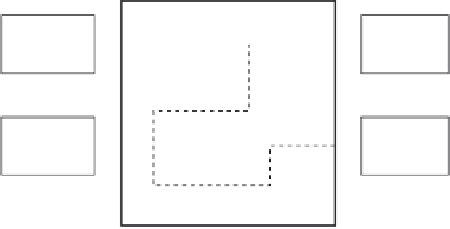Environmental Engineering Reference
In-Depth Information
Conventional
conversion and delivery efficiency
Electric
load
Electricity
company
36%
5 kW
el
1.8 kW
el
Gas
company
Thermal
load
7.5 kW
th
6 kW
th
80%
Figure 4.8
Delivery efficiency of electricity and heat through conventional methods
Conversion and delivery efficiency
with micro-CHP
0.81 kW
el
+
Electricity
company
Electric
load
2.25 kW
el
36%
1.8 kW
el
0.99 kW
el
13%
Gas
company
+
Thermal
load
7.6 kW
th
Micro-CHP
6 kW
th
79%
Figure 4.9
Delivery efficiency of electricity and heat considering a
cogeneration unit
When using a conventional boiler:
Needing 6 kW
th
of thermal power and if the water is heated through a gas fuelled
boiler with an 80% efficiency, then 7.5 kW
th
of power is required from the
primary source;
●
If concurrently, 1.8 kW
el
of electricity is demanded and assuming a combined
generation and delivery efficiency of 36%, then 5 kW
el
of power is needed from
the primary source.
●
In this example, the total energy supplied into the energy service networks is
12.5 kW although only 7.8 kW reaches the end-user.
However, if a CHP Stirling engine system with an overall efficiency of 92% is
used [187]:
The thermal power efficiency of the Stirling engine is 79%, thus in order to obtain
6kW
th
it requires 7.6 kW
th
from the primary source;
●
Similarly, if the Stirling engine has a 13% electrical power generating efficiency
and consumes 7.6 kW
th
, then 0.99 kW
el
can be generated on-site;
●










































Search WWH ::

Custom Search